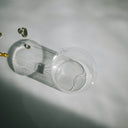Hair loss is a complex issue influenced by genetics, hormones, and lifestyle. Among hormonal factors, progesterone—a key female sex hormone—often sparks confusion. While it’s essential for reproductive health and pregnancy, its relationship with hair growth is nuanced. Can progesterone imbalances lead to thinning hair or exacerbate shedding? This article dives into the science behind progesterone’s role in hair health, explaining how both high and low levels may contribute to hair loss and what you can do to restore balance.
Table of content
Can Progesterone Cause Hair Loss?
Yes, progesterone can contribute to hair loss in certain situations. Excessively high or low progesterone levels may disrupt the hair growth cycle. High progesterone can indirectly increase androgens (like DHT), which shrink hair follicles, while low progesterone (often seen in perimenopause) may lead to estrogen dominance, triggering shedding. However, progesterone also has protective effects—it blocks DHT in some contexts. The impact depends on individual hormonal balance, genetics, and whether synthetic progestins are involved.
As your leading source for hair health information over the past 4 years, we never compromise on accuracy. When it comes to your health, you deserve information you can truly rely on - and earning your trust is our top priority.
Here's how Scandinavian Biolabs ensures every piece of content meets the highest standards of accuracy and integrity:
- Credentialed Experts: Our reviewers are actively practicing doctors and medical researchers
- Stringent Reviews: Content undergoes rigorous editing by subject specialists and review by a practicing doctor.
- Evidence-Based: We rely on well-established research from trusted scientific sources like peer-reviewed journals and health authorities.
- Full Transparency: Our editorial standards, writer credentials, reviewer credentials, correction process, and funding are all publicly documented.
- Independent Voice: While we do promote products, we operate in a vacuum to business operations. Our main goal is just an unwavering commitment to providing medically-sound guidance.
You can count on Scandinavian Biolabs to consistently deliver the trustworthy health information you deserve. Read our Editorial Standards.
Progesterone’s Role in Hair Health
Progesterone interacts with hair follicles in several ways:
1. Androgen Conversion and DHT
Progesterone can convert into androgens like testosterone via enzymes in the skin and hair follicles. Testosterone then converts to dihydrotestosterone (DHT), a hormone that binds to follicles, miniaturizing them and shortening their growth phase. Women with genetic sensitivity to androgens are especially prone to this process.
2. Estrogen-Progesterone Balance
Progesterone counterbalances estrogen. When progesterone drops (e.g., during perimenopause), estrogen dominance can occur, leading to inflammation and prolonged hair shedding (telogen effluvium).
3. Hair Growth Cycle Regulation
Progesterone supports the anagen (growth) phase by promoting follicle cell proliferation. Low levels may shorten anagen, leading to thinner hair over time.
4. Synthetic Progestins vs. Natural Progesterone
Synthetic progestins (found in birth control pills and HRT) have different effects than bioidentical progesterone. Some progestins, like norethindrone, have androgenic activity, worsening hair loss in susceptible individuals.
When Progesterone Causes Hair Loss: Key Scenarios
1. Postpartum Hormonal Shifts
After childbirth, progesterone levels plummet from very high to low rapidly. This sudden shift pushes hair follicles into the telogen (resting) phase, causing postpartum shedding 2–4 months later.
2. Perimenopause and Menopause
Progesterone declines earlier and more steeply than estrogen during perimenopause. Estrogen dominance increases inflammation and prolongs shedding, while lower progesterone reduces DHT-blocking effects.
3. Polycystic Ovary Syndrome (PCOS)
Women with PCOS often have low progesterone due to irregular ovulation, combined with high androgens. This imbalance accelerates follicle miniaturization and shedding.
4. Progestin-Based Birth Control
Androgenic progestins in some contraceptives (e.g., Depo-Provera, levonorgestrel IUDs) can raise DHT levels, triggering hair loss in those with androgen sensitivity.
5. Adrenal Dysfunction
Chronic stress depletes progesterone as the adrenal glands prioritize cortisol production. Low progesterone exacerbates estrogen dominance and inflammation.
When Progesterone May Prevent Hair Loss
In balanced amounts, progesterone can protect hair health by:
- Blocking DHT: Bioidentical progesterone competes with 5-alpha reductase, the enzyme that converts testosterone to DHT.
- Reducing Inflammation: It suppresses inflammatory cytokines that damage follicles.
- Supporting Thyroid Function: Progesterone aids T4-to-T3 conversion; low thyroid hormones cause diffuse thinning.
Diagnosing Progesterone-Related Hair Loss
A healthcare provider may:
- Test Hormone Levels: Blood or saliva tests for progesterone, estrogen, DHT, and thyroid hormones.
- Assess Symptoms: Irregular periods, hot flashes, or acne suggest hormonal imbalance.
- Examine Hair Patterns: Thinning at the crown or temples suggests androgenetic alopecia.
Treating Progesterone-Linked Hair Loss
1. Natural Progesterone Therapy
Bioidentical progesterone creams or oral micronized progesterone (Prometrium) can restore balance in perimenopause or PCOS, blocking DHT without androgenic side effects.
2. Anti-Androgen Medications
- Spironolactone: Blocks androgen receptors and reduces DHT production.
- Finasteride/Dutasteride: Inhibits 5-alpha reductase (off-label use for women).
3. Topical Treatments
- Minoxidil 5%: Stimulates follicles and extends the growth phase.
- Progesterone-Infused Serums: Limited evidence, but may help locally block DHT.
4. Lifestyle Adjustments
- Stress Reduction: Yoga, meditation, and adaptogens (ashwagandha) lower cortisol.
- Diet: Cruciferous vegetables (broccoli, kale) support estrogen metabolism.
- Exercise: Regular activity improves insulin sensitivity and hormone balance.
5. Avoid Androgenic Progestins
Switch to low-androgen contraceptives like desogestrel or drospirenone-containing pills (Yaz, Slynd).
FAQs About Progesterone and Hair Loss
Can Progesterone Creams Cause Hair Loss?
Rarely. Most contain bioidentical progesterone, which is anti-androgenic. However, overdosing may temporarily disrupt balance.
Does Postpartum Hair Loss Mean Progesterone Deficiency?
No—it’s a normal response to sudden progesterone withdrawal. Hair typically regrows within a year.
Is Progesterone-Related Hair Loss Permanent?
Not if treated early. Restoring hormonal balance often reverses thinning unless follicles are scarred.
Can Progesterone Help Menopausal Hair Thinning?
Yes. Combined with estrogen, it reduces inflammation and DHT, improving hair density in many women.
How Long Before Progesterone Therapy Regrows Hair?
Minimum 3–6 months, as hair cycles are slow. Consistency with treatment is key.
Conclusion: Progesterone’s role in hair loss is multifaceted. While imbalances can trigger shedding, optimal levels protect against androgens and inflammation. Identifying root causes—like synthetic progestins, estrogen dominance, or PCOS—enables targeted treatments. Through hormone testing, lifestyle changes, and medical therapies, most individuals can stabilize hair loss and encourage regrowth. Consult an endocrinologist or dermatologist for personalized care.
Tired of Thinning Hair? Try a Clinically Tested Serum.
Looking for a natural way to regrow hair and achieve a thicker, fuller head of hair? Ditch the stinging nettle for hair loss – Bio-Pilixin Serum is a drug-free hair activation serum that delivers clinically tested results.
Here's why Bio-Pilixin is superior:
- Clinically Tested Results: 93% of users saw a reduction in hair loss, and 73% experienced increased hair density.
- Safe and Natural: Unlike harsh chemicals, Bio-Pilixin uses plant growth factors derived from stem cell technology to nourish hair follicles and stimulate growth.
- Fast-Acting: See visible results in as little as 45 days (most typically see results within 150 days).
Stop wasting time on unproven remedies. Bio-Pilixin is the safe, natural serum you've been searching for.
Read more:






